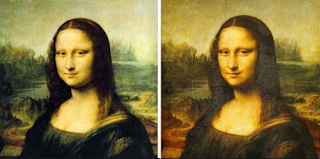Week 2- Math + Art
It is always mesmerizing looking at a piece of art and appreciating it for what it is right in front of you. In Victoria Vesna’s lecture “Mathematics-pt1-Zero Perspective Golden Mean” shows all many different techniques artist put in their work behind the scenes. One of the main points of the lecture that grabbed my attention was “The Golden Ratio” which is the ultimate connection between the actual art of a drawing, painting, portrait etc. and the mathematics. This rule has been around for centuries, and we have began to see it being drawn out into other occupation, like architecture and engineering.
(Courtesy of: http://www.losingblueprint.com)
The novel “Flatland” by Edwin A. Abbott really made his reader open their eyes on perspective. The main character, A. Square is in a two dimensional world when he is taken on a series of trips and daydreams through other dimensions. he realized that the two dimensional world he lives in isn't the only world out there. When he tries to tell other people about what he has seen, he gets thrown in prison by his close minded leaders. Linda Dalrymple Henderson encourages people to “reject completely the one point perspective system" and “adapt to the thought of a fourth dimension” in her article “The Fourth Dimension and Non-Euclidean Geometry in Modern Art: Conclusion.” Victoria Vesna also highlights the idea of getting out of the one perspective mindset in her lecture “Math and Art Introduction”. She says “our perspectives are being reduced due to what we are being taught in the education systems.” While I do think this idea is being solves in one direction, by making students take a variety of classes before narrowing down their major, the way things are being taught is narrowing the perspective. The perspective of the material we are taught and how we are taught should be wide ranged.
(Courtesy of: http://www.cantontower.com/en/Sightseeing.aspx?code=0307)
Mark Frantz talks about how artist draw their images a certain way to get their audience to look at one place rather than the other. In his “Lesson 3: Vanishing Points and Looking at Art” he takes us step by step to show us how artist create their drawings using techniques to get their audience to look one way, but some artist have figured out how to have their images appear one way at a certain angle, and a different at another. This picture is a good example of perspective and different viewing points. If you view the first picture head on, most people would see an old lady, but once you flip the portrait upside down, you see a young woman. While this is a very well known picture, ideas like this go into many pieces of art, and it would not be able to be done without the background of mathematics. Just another way the two worlds are crossing everyday.
Abbott, Edwin Abbott. Flatland: A Romance of Many Dimensions. New York: Barnes & Noble, 1963. Print.
Frantz, Marc. “Lessoon 3: Vanishing Points and Looking at Art”. http://www.cs.ucf.edu/courses/cap6938-02/refs/VanishingPoints.pdf. 2000.
Henderson, Linda Dalrymple. "The Fourth Dimension and Non-Euclidean Geometry in Modern Art: Conclusion." Leonardo 17.3 (1984): 205. Web.
Math and Art Introduction. Perf. Victoria Vesna. N.p., 26 Mar. 2012. Web. <https://www.youtube.com/watch?v=eHiL9iskUWM>.
Mathematics-pt1-ZeroPerspectiveGoldenMean.mov. Perf. Victoria Vesna. N.p., 9 Apr. 2012. Web. <https://www.youtube.com/watch?v=mMmq5B1LKDg>.
Math and Art Introduction. Perf. Victoria Vesna. N.p., 26 Mar. 2012. Web. <https://www.youtube.com/watch?v=eHiL9iskUWM>.






I think it's fascinating how artists can draw an image that has different pictures in it depending on the point of view that you see it from. The photos at the bottom are classic but they are the best example of this.
ReplyDeleteHi jordan. I like the connection you made between flatland and Victoria Vesna's idea about how our education system reduces our perspective. We have been trained since an early age to think a certain way and it's very important to recognize this and be able think outside the box. It's not just about speculating about a 4th dimension but also looking at different perspectives of everyday life because a huge part of how we evolve as a society is challenging what we think we know.
ReplyDeleteI really like your example in the end. It illustrates that different view points create different images very well. Also, I like the connection you made how the change of perspective influences that students now are limited to one major. We become more and more used to think in certain ways, instead of viewing the world in different perspectives.
ReplyDeleteI want to focus on your last paragraph about Mark Frantz and the way that artists draw there images. It is really amazing to see how simply changing a few lines or maybe even shading differently can completely change the focus point of a picture or make it look like something it is not. This observation by you is very good and one we can easily apply to our lives today. Often times on social media we can come across pictures that make us stop and think how they drew that.
ReplyDelete